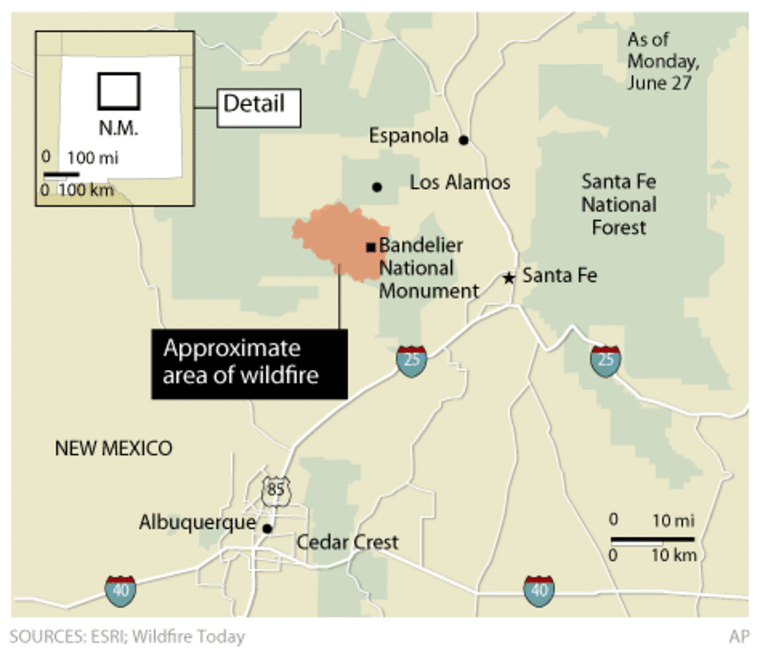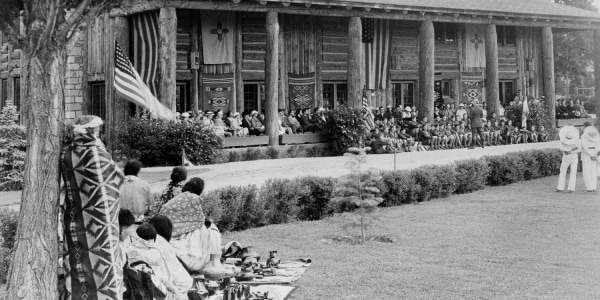Firefighters for the first time gained control of a small edge of the fire near the Los Alamos National Laboratory on Wednesday, but were on alert for any spot fires that might fall within the nuclear weapons lab or nearby town.
The so-called Las Conchas Fire, which continues to throw small fires onto Los Alamos National Laboratory, has grown to nearly 70,000 acres, fire information officer Linda Kearns said.
But about three percent of the fire's perimeter was finally contained, the first time firefighters were able to make headway on the blaze that had burned out of control since Sunday.
Some 350 firefighters and five helicopters have been battling the blaze, and more than 600 more crews were expected to join the firelines Wednesday.
"This is as dry as you can get, I've never seen it this dry," Los Alamos County Fire Chief Doug Tucker said at an afternoon press conference where he explained a plan to protect the town by clearing brush.
Kearns earlier reported "spots" had fallen on lab property "but they're putting them out pretty much right away."
However, Tucker later said he had no information about any additional spot fires beyond one put out on Monday.
A buried natural gas pipeline running near the northern edge of the fire has been turned off as a precaution, incident fire commander Joe Reinarz said. Los Alamos laboratory officials have been shutting down gas lines since the fire began to encroach on lab property earlier this week.
Both the town of Los Alamos, home to about 12,000 residents, and the laboratory, with a work force of about 15,000, were evacuated on Monday. The lab is scheduled to be shut down at least through Thursday.
Situated on a hilltop 35 miles northwest of Santa Fe, the lab property covers 36 square miles and includes about 2,000 buildings, none of which have yet burned.
Established during World War Two as part of the top-secret Manhattan Project to build the first atomic bomb, the complex remains one of the leading nuclear arms manufacturing facilities in the United States.
At a community meeting late on Tuesday, hundreds of evacuees gathered in a local gymnasium to hear updates and voice concern about about the potential of a radioactive smoke plume if the flames reach thousands of barrels of waste stored in above-ground tents at the lab.
Mai Ting, a doctor living in nearby Pojoaque, said she was frustrated by the lack of information on how to stay safe.
"I'm not a fearmonger, but there's a reason this story is on the national and world news. It's because of the nuclear lab. I don't trust this fire," she said.
She added that she thought people staying near the fire should be consuming lots of potassium iodide and seaweed to counteract the potential effects of radiation.
"What do I tell my children and grandchildren?" she said. "Well, they've left. I didn't want them around here."
Some residents who decided to wait out the fire weren't concerned, including Mark Smith, a chemical engineer who works at the lab.
"The risk of exposure is so small. I wouldn't sit here and inhale plutonium. I may be crazy, but I'm not dumb," he said.

The Los Alamos complex contains three metric tons of highly radioactive weapons-grade plutonium, stored in concrete and steel vaults in the basement floor of a building near the center of the complex, with an air-containment system surrounding it, according to John Witham, a spokesman for the anti-nuclear watchdog group Nuclear Watch New Mexico.
Top lab officials and fire managers say there have been no releases of toxins. They say they're confident the flames won't reach key buildings or areas where radioactive waste is stored. As a last resort, foam could be sprayed on the barrels containing items that might have been contaminated through contact with radioactive materials to ensure they aren't damaged by fire, they said.
The site's manager for the National Nuclear Security Administration said he evaluated the precautions and felt comfortable. The agency oversees the lab for the Department of Energy.
"I have 170 people who validate their measures," Kevin Smith said. "They're in steel drums, on a concrete floor."
Lab Director Charles McMillan said the barrels contain transuranic waste — gloves, toolboxes, tools — and other items that may have been contaminated. An anti-nuclear group had estimated there could be up to 30,000 55-gallon drums stored at a site known as Area G, but lab spokeswoman Heather Clark said Wednesday there are 10,000 drums stored there under fire-retardant tents.
Tucker, whose fire department is responsible for protecting the lab, said the barrels are stacked about three high inside the tents.
Area G holds drums of cleanup from Cold War-era waste that the lab sends away for storage in weekly shipments, according to lab officials.
Still, lab officials called in teams late on Monday to monitor air quality, with high-volume air samplers ready to deploy.
Their effort includes dozens of fixed-air monitors on the ground, as well as a "flying laboratory" dispatched by the U.S. Environmental Protection Agency. The special twin-engine plane is outfitted with sensors that can collect detailed samples.
Kearns said firefighters from Wyoming, Texas, Colorado, Utah and California had been brought in to help fight the blaze, which began Sunday from what authorities believe was a tree falling on a power line.
"We are throwing absolutely everything at this that we got," Democratic Sen. Tom Udall of New Mexico said in Los Alamos.
The fire grew by 10,000 acres overnight and has now burned through nearly 70,000 acres, or 108 square miles, of Santa Fe National Forest. Hot temperatures and gusts of up to 40 miles per hour were expected for Wednesday.
"Everything is just so dry and ready to burn," Tucker said. "We need some rain. Snow would be nice." He added that even containment lines had dangerous smoldering stumps and burning roots that could easily ignite fires.
Twelve homes and 18 other structures have been destroyed by the fire.
Reinarz said firefighting efforts would now be separated into two zones — a Northeast and a Southwest section — each with its own command section.
The wildfire has destroyed 30 structures south and west of Los Alamos, for many stirring memories of a blaze in May 2000 that destroyed hundreds of homes and buildings in town.
